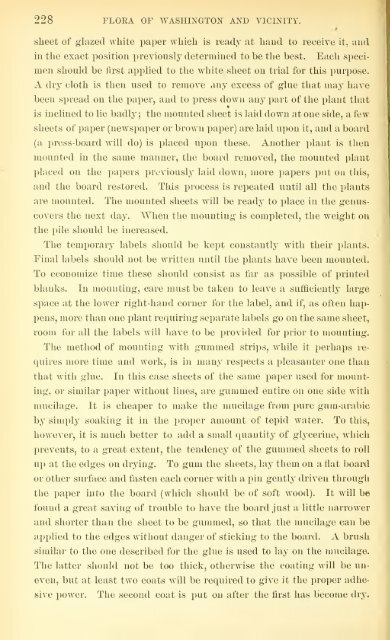Bulletin - United States National Museum - Smithsonian Institution
Bulletin - United States National Museum - Smithsonian Institution
Bulletin - United States National Museum - Smithsonian Institution
Create successful ePaper yourself
Turn your PDF publications into a flip-book with our unique Google optimized e-Paper software.
228 FLOEA OF WASHINGTON AND VICINITY.<br />
sheet of glazed white paper which is ready at hand to receive it, and<br />
iu the exact i)osition previously determined to be the best. Each specimen<br />
should be first applied to the white sheet on trial for this purpose.<br />
A dry cloth is then used to remove any excess of glue that may have<br />
been spread on the paper, and to i)ress down any part of the plant that<br />
is inclined to lie badly 5<br />
the mounted sheet is laid down at one side, a few<br />
sheets of jjaper (newspaper or brown pai^er) are laid upon it, and a board<br />
(a press-board will do) is placed upon these. Another plant is then<br />
mounted in the same manner, the board removed, the mounted plant<br />
placed on the papers previously laid down, more papers put on this,<br />
and the board restored. This process is repeated until all the plants<br />
are mounted. The mounted sheets will be ready to place in the genus-<br />
covers the next day. When the mounting is completed, the weight on<br />
the pile should be increased.<br />
The temporary labels should be kejit constantly with their plants.<br />
Final labels should not be written until the i^lants have been mounted.<br />
To economize time these should consist as far as i)0ssible of printed<br />
blanks. In mounting, care must be taken to leave a sufficiently large<br />
space at the lower right-hand corner for the label, and if, as often hap-<br />
pens, more than one plant requiring separate labels go on the same sheet,<br />
room for all the labels will have to be provided for prior to mounting.<br />
The method of mounting with gummed strips, while it perhaps re-<br />
quires more time and work, is in many respects a pleasanter one than<br />
that with glue. In this case sheets of the same paper used for mount-<br />
ing, or similar pajjer without lines, are gummed entire on one side with<br />
mucilage. It is cheaper to make the mucilage from pure gum-arabic<br />
by simjily soaking it in the proper amount of tepid water. To this,<br />
however, it is much better to add a small quantity of glycerine, which<br />
prevents, to a great extent, the tendency of the gummed sheets to roll<br />
up at the edges on drying. To gum the sheets, lay them on a flat board<br />
or other surface and fasten each corner with a pin gently driven through<br />
the paper into the board (which should be of soft wood). It will be<br />
found a great saving of trouble to have the board just a little narrower<br />
and shorter than the sheet to be gummed, so that the mucilage can be<br />
applied to the edges without danger of sticking to the board. A brush<br />
similar to the one described for the glue is used to lay on the mucilage.<br />
The latter should not be too thick, otherwise the coating will be un-<br />
even, but at least two coats will be required to give it the proper adhe-<br />
sive power. The second coat is put on after the first has become dry.<br />
«

















